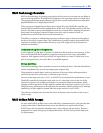
Appendix A: Introduction to SAS ● 58
Terminology Used in This Appendix
For convenience, SAS HostRAID controllers are referred to generically in this appendix as SAS
controllers, HBAs, disk drives, and external disk drive enclosures are referred to as end devices
and expanders are referred to as expander devices.
For convenience, this chapter refers to end devices and expander devices collectively as SAS
devices.
What is SAS?
Legacy parallel SCSI is an interface that lets devices such as computers and disk drives
communicate with each other. Parallel SCSI moves multiple bits of data in parallel, using the
SCSI command set.
SAS is an evolution of parallel SCSI to a point-to-point serial interface. SAS also uses the SCSI
command set, but moves multiple bits of data one at a time. SAS links end devices through
direct-attach connections, or through expander devices.
SAS controllers can typically support up to 128 end devices and can communicate with both
SAS and SATA devices. You can add 128 end devices or even more with the use of SAS
expanders. For more information, see SAS Expander Connections on page 61.
Although you can use both SAS and SATA disk drives in the same SAS domain, Adaptec
recommends that you not combine SAS and SATA disk drives within the same array or logical
drive. The difference in performance between the two types of disk drives may adversely affect
the performance of the array.
Data can move in both directions simultaneously across a SAS connection (called a link—see
next section). Link speed is 600 MB/sec in full-duplex mode. A SAS controller with eight links
has a maximum bandwidth of 4800 MB/sec in full-duplex mode.
Although they share the SCSI command set, SAS is conceptually different from parallel SCSI
physically, and has its own types of connectors, cables, connection options, and terminology, as
described in the rest of this chapter.
To compare SAS to parallel SCSI, see page 62.


















